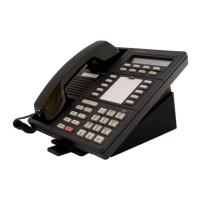MERLIN LEGEND Communications System Release 6.1
Feature Reference
555-661-110
Issue 1
August 1998
Features
Page 525Primary Rate Interface (PRI) and T1
to the PSTN or, in a network, may be the same type of port on a non-local system.
When the source for clock synchronization is a local system module, it is assigned
as
local
. There can be no more than one local clock source for digital tandem
facilities in a network, and all other tandem facilities are assigned as loop. There
does not have to be any local clock source in a network; all can be loop.
Networked systems do not always have an in-service digital PSTN facility
available or active. For this reason, clock synchronization in some private
networks requires choosing among other clock sources. In a network with three or
more systems, it is best if all clock sources for the network are on either a hub
system (star configuration) or a system that connects two other switches (series
configuration). If the primary clock source is not functioning, then a secondary or
tertiary source on such a system can serve either all other systems in the network
or two other systems in a network. If a DEFINITY ECS or DEFINITY ProLogix
Solutions system is included in the network and has functional digital PSTN
facilities, it should provide the clock synchronization source. Details and examples
are provided in the
Network Reference.
The following lists the options for primary, secondary, and tertiary clock
synchronization sources in order of preference:
1. The clock sources on BRI ports with Digital Subscriber Lines (DSLs) in
service. If at all possible, all three clock sources should be on the same 800
NI-BRI module. If they are not, interruptions in high-speed data calls can
occur when the clock source switches to a backup source
2. The loop clock source on any 100D module
3. The loop clock source on any 100D module in T1 mode emulating tie
trunks
4. The local clock source on any 100D module
NOTE:
Ports that are not in service should never be programmed as clock
sources.
Clock Switching 37
When the primary clock source is not able to provide the system clock, the
secondary clock source is used, if it exists and is capable of providing the system
clock. If the secondary clock source is incapable of providing the system clock,
the tertiary clock source is used.
If none of these is capable of providing the system clock, the communications
system searches 800 NI-BRI and 100D modules for a clock source, starting from
the first module in the system and ending with the last module. The clock is
chosen with the following order of preference:
1. Loop clock source on an 800 NI-BRI or 100D module
2. Local clock source on an 800 NI-BRI or 100D module

